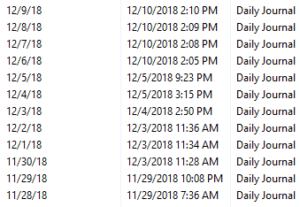Being the data nerd that I am, I wanted to not only organize my life more but also track it! In addition to all the processes I put in place for task organization and note taking, I needed a method for tracking certain relevant life data points.
I use two main applications for this part of the system: Google Sheets and Evernote. Similar to how I outlined my use of these two products for reference lists, I use Sheets for individual data inputs and Evernote for long-form notes. Let’s dive in.
Daily Tracking in Google Sheets
I have two main workbooks I update on a daily basis. One is solely for tracking daily fitness activities and the other is a mix of health/wellness inputs.
Fitness Tracking
My primary goal here is to track what activity I am doing and when I did it. I want to see how many times I did certain activities in a defined time period (e.g. How many days did I snowboard in the 2017/2018 season? Answer: 30). The secondary goal is to track improvement in two main activities: running and climbing. I only have 6 columns in my sheet as shown in the example below*. Since I am mostly concerned with running and climbing the Distance/Grade column is catered to those (also used for mountain biking to mark mileage) with Distance shown as miles and Grade as Yosemite for sport climbing and V scale for bouldering. Effort is a 1-5 scale and useful for tracking how hard I feel I worked out.

Health/Wellness Tracking
This sheet is designed to track areas of improvement, daily habits, wellness data, and items related to health. Since this data is much more personal, I have chosen to show an example* of how this type of tracking could be laid out. However, certain aspects are similar to my own sheet. As you can see, there is a section for daily habits and sections for health/wellness. The goal is more about tracking trends than gathering loads of specific information. Conventional wisdom says it takes 21 days to make something a habit, but one study showed the average might be more like 66 days!

*Data is made up for these samples.
Daily Journal in Evernote
I keep a daily journal in Evernote to help me remember certain events and to also allow for introspection after events. The layout is meant for shorthand notes, but I do write lengthier entries at times. I ask myself the below questions. Oddly, I have found the hardest thing to remember is what I learned.
- What was good?
- What was bad?
- What did I accomplish?
- What did I fail to do?
- What did I learn today?
- Funny story or other noteworthy item?

Benefits?
The real question is “Has any of this data gathering actually provided value?” For me, the answer is yes. I started tracking most of the data points about a year ago and some things I have learned are as follows:
- By forcing myself to write a good and bad entry each day in my journal, I see some positive on my “bad” days.
- Time flies by. It is astonishing how quickly you get behind on a habit.
- Tracking my fitness activities gives me a push to not have any blank days even if it is only stretching and core exercises.
- Even with the barebones approach to my journal, I have used it many times to go back and reference things.
- I feel like I have a better pulse on my “status.” How well am I doing in my goals, where is my head at, etc.
I continue to edit and evolve my tracking as data points become irrelevant or new desires emerge. With the right layout, it is easy to be fluid with your tracking. If you do any tracking or have questions/comments, please drop me an email or leave a comment on this post. It will be interesting for me to see what others are doing.